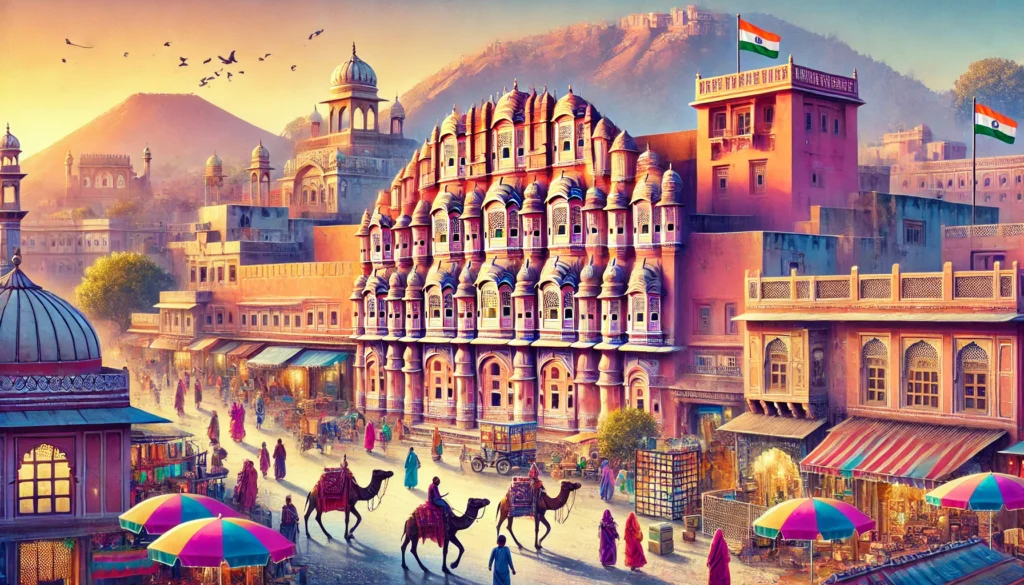
Jaipur , also known as the “Pink City” , is the capital of the Indian state of Rajasthan. The city is famous for its historical heritage , rich culture , and unique architecture. Jaipur was founded in 1727 by Sawai Jai Singh II and is considered to be India’s first planned city.
Geographical location
Jaipur is located in the northwestern part of India. It is situated in the lap of the Aravalli mountain range. Its height is about 431 meters above sea level. The city is surrounded by desert areas , which give it a unique natural beauty.
History
Jaipur was founded by Sawai Jai Singh II, the ruler of Amer. It was developed as a planned city and its architecture followed the principles of Vastu Shastra. The major buildings and markets of the city were painted pink , which symbolizes respect and hospitality towards guests.
Culture and Tradition
Jaipur is famous for its rich cultural tradition. People here wear traditional dress ; women wear “Ghaghra-Choli” and men wear “Safa”. The art , music , and dance (such as Goomar dance) here reflect the local folk culture.
Tourist Spots
Tourism in Jaipur is a center of attraction for Indian and foreign tourists. There are many historical forts , palaces , and museums here:
- Amer Fort : A magnificent fort situated on a hill , famous for its architecture and Sheesh Mahal.
- Jaigarh Fort : The world’s largest cannon ‘ Jaiban ‘ is located here.
- Nahargarh Fort : This fort provides a beautiful view of the city.
- City Palace : It is the residence of the royal family and also serves as a museum.
- Hawa Mahal : A unique palace built for women , which has 953 windows.
- Jal Mahal : A magnificent palace situated in the middle of the Man Sagar Lake.
- Jantar Mantar : UNESCO World Heritage Site , famous for its astronomical instruments.
Food & Drink
Jaipur food offers a delicious experience of local Rajasthani cuisine. The main dishes are:
- Dal-Baati-Churma
- Ghevar
- Kesariya Lassi
- Mirchi big
- Onion Kachori
Festivals and fairs
Many festivals and fairs are organized throughout the year in Jaipur , some of the major ones are:
- Gangaur Festival : Traditional festival celebrated by women.
- Teej Festival : It is celebrated by women in the month of Sawan.
- Jaipur Literature Festival : World famous literary event.
- Elephant Festival : Display of colourful elephants.
Modernity and development
Jaipur is a rapidly developing city. It is part of the “Golden Triangle” (Delhi-Agra-Jaipur) and has many modern facilities , such as metro rail , international airport , and IT sector.
conclusion
Jaipur is a wonderful blend of its historical heritage and modernity. This city is not only the pride of Rajasthan but also a symbol of India’s cultural heritage. Visiting Jaipur will give you unique experiences and memories.
Geographical location

Detailed description of the geographical location of Jaipur
Jaipur is the largest city and capital of the Indian state of Rajasthan. This city North-West India It is located in and is geographically important because it is situated near the Aravalli mountain range. It is located in the eastern part of Rajasthan and has a special place due to its location at the confluence of desert areas and fertile plains.
latitude and longitude
Latitude of Jaipur 26.92° N and longitude 75.82° E It is located at an altitude of about 431 meters ( 1417 feet) above sea level. Its geographical location makes it suitable for connecting to other major cities of India , such as Delhi and Agra .
environmental structure
- Aravalli Range :
Jaipur is situated in the shadow of the Aravalli Range , which provides it with a natural boundary. These mountains play an important role in maintaining a balance in climate and environment between the arid and semi-arid regions of Rajasthan. - Desert region :
Jaipur is close to the Western Thar Desert , which affects it with an arid climate. However , the climate here is not completely desert , as the Aravalli mountain range protects it from the expansion of the Thar. - Water Resources :
Major water sources near Jaipur Man Sagar Lake And other small lakes are included. Here the rain water during monsoon is stored in reservoirs , which fulfills the water requirements. Apart from this , water is also supplied from the canal projects of Rajasthan.
climate
The climate of Jaipur Semi -Arid Climate It is classified as a tropical rainforest. There are mainly three seasons here:
- Summer (March to June) :
Temperatures range from 30°C to 45°C . Summers are dry and windy. - Monsoon (July to September) :
Rainfall is usually around 600-650 mm. Rainfall is irregular due to the Aravalli range. - Winter (November to February) :
The temperature in winter ranges from 8°C to 22°C . This time is most suitable for tourism.
geographical feature
- Biodiversity :
The Aravalli mountain range of Jaipur and its surrounding areas are rich in biodiversity. A variety of plants and animals are found here. For example , Sariska Tiger Reserve and Jhalana Leopard Safari are located near it. - Soil :
The soil of Jaipur is mainly sandy , which is characteristic of arid areas. Traditional water structures , such as stepwells , are also present here for water storage . - Seismic Zone :
Jaipur falls in seismic zone- II and III , which means the region is moderately vulnerable to earthquakes.
Location and connectivity
Jaipur is connected to several major cities of North India:
- Delhi : About 268 km away (via National Highway 48 ).
- Agra : About 240 km away (via National Highway 21 ).
- Udaipur : 400 kms. This strategic location of Jaipur makes it Golden Triangle (Delhi-Agra-Jaipur) It forms part of the , which is important for both tourism and business.
conclusion
The geographical location of Jaipur makes it an important centre from historical , cultural and business point of view. Being close to the Aravalli Hills and the Thar Desert, its climate , topographical structure and environmental balance make it unique. Jaipur is not only the pride of Rajasthan , but its geographical location also makes it a major city at the national and international level.
History
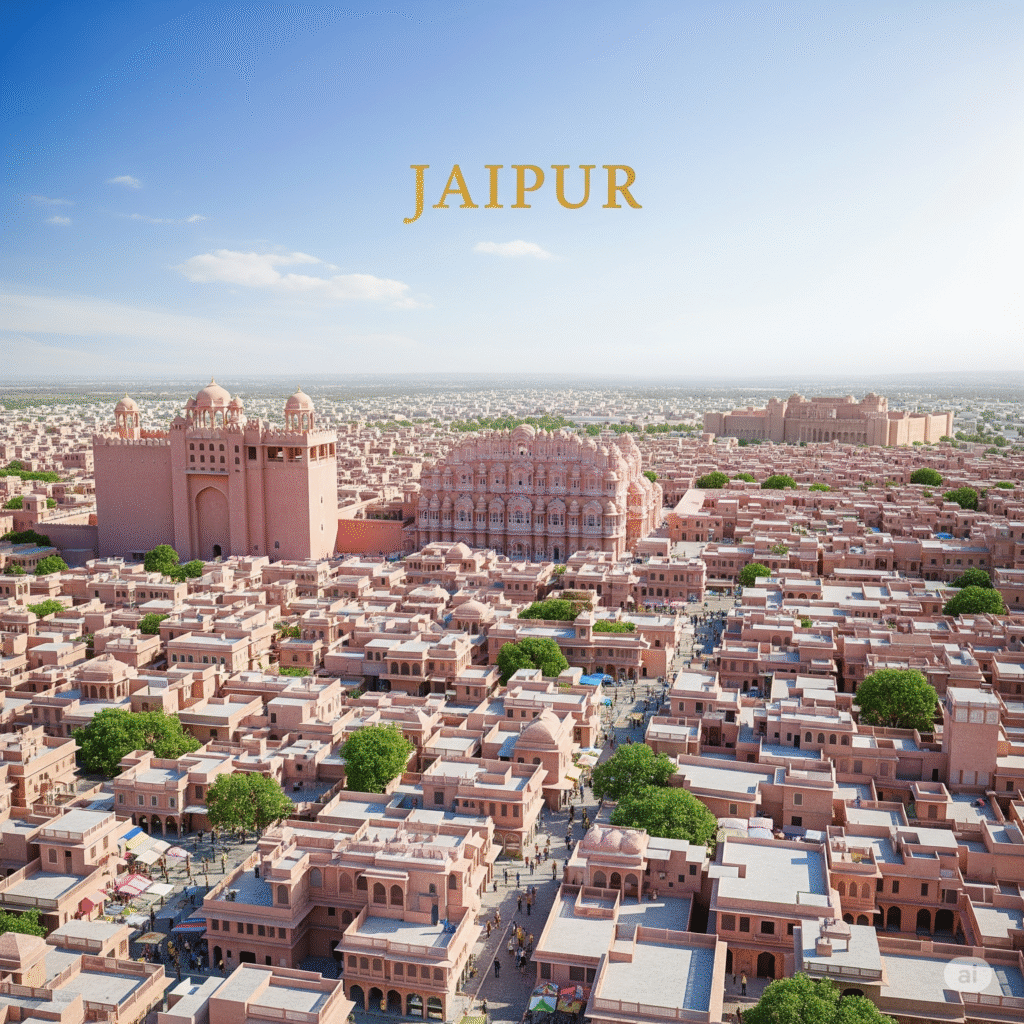
Detailed history of Jaipur
Jaipur , known as the “Pink City” , is famous for its historical heritage , architectural excellence , and Rajput valor. It is India’s first planned city , laid out in the 18th century by Sawai Jai Singh II. Jaipur’s history is unique and diverse due to its Rajput , Mughal, and British influences.
Founding of Jaipur
- Sawai Jai Singh II ( 1688–1743) :
Jaipur was founded in 1727 by the king of Amer state Sawai Jai Singh II It was done by.- Jai Singh was the ruler of the Kachchwaha dynasty of Amer and he realised that the Amer Fort was not capable of meeting the rapidly growing population and administrative needs.
- Therefore , he founded Jaipur near the Aravalli Hills.
- was famous for his deep knowledge of astronomy , mathematics and architecture.
- Planned City :
Jaipur is considered to be the first planned city of India.- It was designed by the famous architect of Bengal Vidyadhar Bhattacharya It was settled with the help of.
- town design It was based on the principles of Shilpa Shastra ( ancient architectural texts).
- The city is divided into nine parts , representing the “Navagraha” according to ancient Indian belief.
Identity of the Pink City
In 1876 , on the occasion of the arrival of the Prince of Wales (later King Edward VII) in Jaipur , Maharaja Sawai Ram Singh ordered the entire city to be painted pink.
- to pink color Hospitality and friendliness It is considered a symbol of.
- Since then , Jaipur came to be known as the “Pink City”.
Major dynasties and their contributions
- Kachchwaha Dynasty :
- The Kachchawaha Rajputs ruled Amer and Jaipur from the 10th century .
- Due to his political strategy and strategic skills, Amer and Jaipur became powerful centres.
- He collaborated with the Mughals , which further strengthened his position.
- Mughal Influence :
- The Kachchwaha rulers formed strong political ties with the Mughals.
- Sawai Jai Singh II was given high positions by the Mughal emperor Aurangzeb and his successors.
- The alliance with the Mughals made Jaipur prosperous and culturally developed.
- British Raj :
- In 1818 , Jaipur entered into a treaty with the British East India Company.
- It became a princely state and remained peaceful and stable under British protection.
Relation between Amer and Jaipur
- Before the establishment of Jaipur , Amer This was its main center.
- Amer , about 11 kilometres from Jaipur , was the capital of the Kachchwaha dynasty from the 10th century.
- Amer Fort , built by Raja Mansingh I , was the main residence of the Kachchawaha kings.
- After the establishment of Jaipur , administrative activities from Amer were shifted to Jaipur.
Golden Age of Jaipur
The reign of Sawai Jai Singh II is considered the golden age of Jaipur.
- encouraged science , astronomy , architecture , and the arts.
- Jai Singh built several astronomical observatories (Jantar Mantars) , of which the Jantar Mantar in Jaipur is today a UNESCO World Heritage Site.
- He built the City Palace , Hawa Mahal , and many other magnificent buildings.
British era and freedom struggle
- British subjugation :
- 19th century , Jaipur maintained its status as a British princely state.
- The administrative and cultural development here took place under British patronage.
- Role in freedom struggle :
- Jaipur participated indirectly in the Indian freedom struggle.
- Many freedom fighters led movements from here.
- Jaipur after 1947 :
- After the independence of India , Jaipur became the capital of the state of Rajasthan.
- Jaipur , formerly a princely state , plays a key role in the unification of Rajasthan.
Cultural Heritage of Jaipur
Cultural and architectural heritage has a special place in the history of Jaipur.
- , forts and temples here are symbols of Rajput art and culture .
- The history of Jaipur is not just limited to war and politics ; it has also been a centre of art , literature , and science.
conclusion
is a wonderful amalgamation of
Rajput valor , Mughal influence , and British administration. The city is one of the most important historical cities in India due to its historical heritage , planned architecture , and cultural richness. The founding , development , and heritage of Jaipur make it the “Pride of Rajasthan” and “Pride of India”.
Culture and Tradition
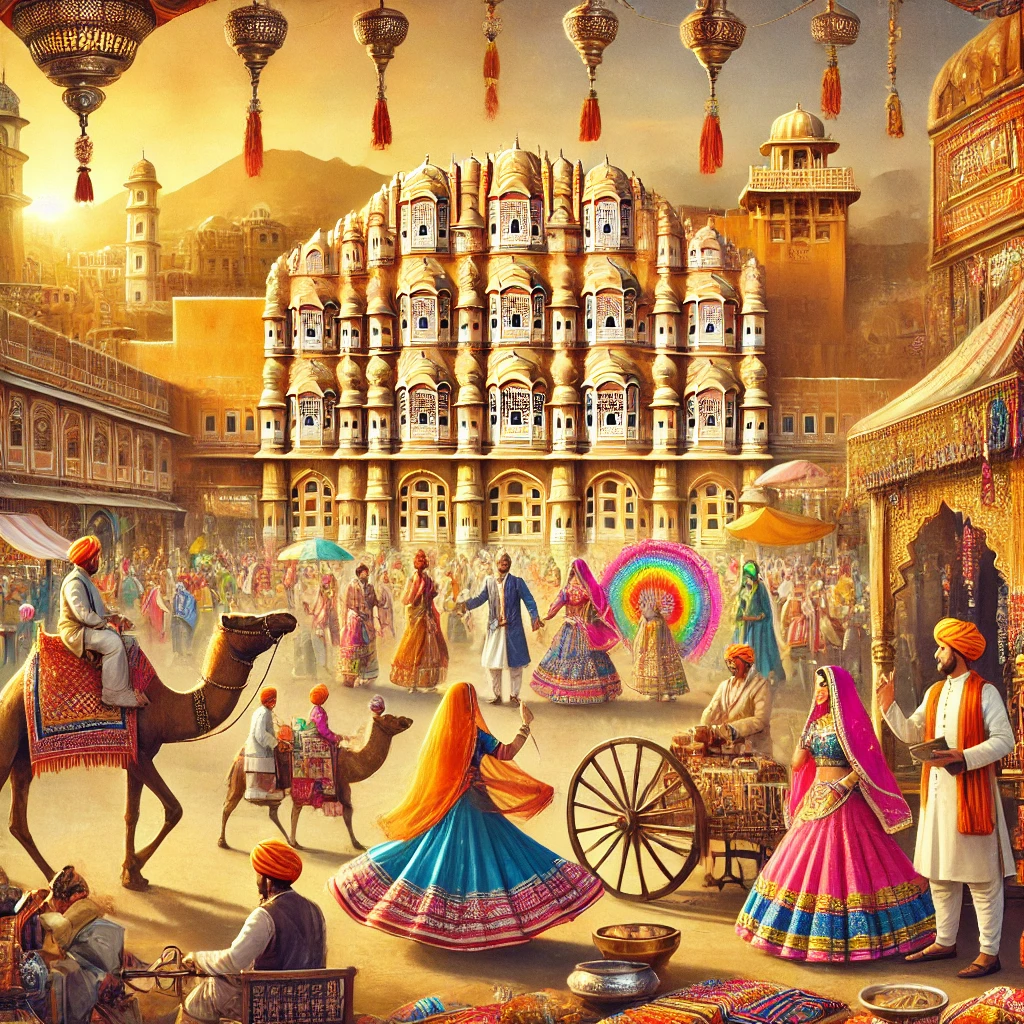
Detailed description of the culture and tradition of Jaipur
Jaipur , known as the “Pink City” , is the capital of Rajasthan and a centre of cultural heritage. The city is famous for its unique traditions , colorful festivals , vibrant folk arts , and rich cultural heritage. The culture of Jaipur is a wonderful blend of Rajput valor , desert lifestyle , and traditional hospitality.
Language and colloquialisms
- Rajasthani language :
People of Jaipur mainly Marwari And Dhundhari They speak , which is a subtype of the Rajasthani language. - Hindi and English :
Hindi is the general language of communication , while English is more commonly used in business and tourism.
uniform
The traditional costumes of Jaipur are an important part of the culture here.
- Men’s Attire :
- Safa : A colourful cloth tied on the head , which is a symbol of pride and dignity.
- Angrakha : The traditional kurta.
- Dhoti : Traditional dress tied at the waist.
- Women’s Dress :
- Ghaghra-Choli : Traditional dress of women.
- Odhani : A colourful sheet worn over the head and shoulders.
- Women’s costumes feature work of Gota , Zari , and embroidery.
Folk arts and crafts
Jaipur’s folk art and crafts are its identity.
- Blue Pottery :
Jaipur’s blue pottery is famous all over the world. - Bandhani and Lahariya :
Fabrics prepared using traditional dyeing and the art of Bandhej. - Jewellery :
Traditional Kundan , Meenakari , and Polki jewellery are made in Jaipur. - Handloom :
Jaipur’s handloom industry gives global recognition to traditional Rajasthani textiles.
music and dance
- Folk Music :
- The folk music of Jaipur is based on tales of heroism , love stories , and stories of rural life.
- from here Morcha , Ravinhatha , and khadtal Like musical instruments are used.
- Folk dance :
- Ghoomar : Traditional dance performed by women.
- Kachhi Ghodi : A dance based on the saga of Rajput bravery.
- Kalbelia : Traditional dance of snake charmers.
Food & Drink
The food of Jaipur is an integral part of its culture and tradition. The dishes here are prepared using spices and traditional methods.
- Rajasthani Thali :
- Daal-Baati-Churma : The most famous traditional food of Jaipur.
- Gatta ki sabji : Curry made from gram flour.
- Kadhi And Millet bread .
- Sweets :
- Ghevar : Special sweet of Jaipur.
- Feeni And Churma Laddu .
- Namkeen and Snacks :
- Mirchi big And Onion Kachori
- Saffron Lassi .
Festivals and celebrations
Jaipur celebrates many colourful festivals and celebrations throughout the year , reflecting its vibrant culture.
- Gangaur Festival :
This is the main festival celebrated by women , in which Gangaur Mata is worshipped. - Teej :
Women’s festival in the month of Saavan , involving swings and folk songs. - Jaipur Literature Festival :
The world’s largest literary festival , which has become the modern cultural identity of Jaipur. - Elephant Festival :
Held during Holi, this festival is a celebration of colourfully decorated elephants. - Makar Sankranti :
Known as the Kite Festival , where the whole city gets involved in kite flying.
Architecture and tradition
The architecture of Jaipur reflects its Rajput tradition and architecture.
- Hawa Mahal : A palace with 953 windows , a blend of Rajput and Mughal architecture.
- Amer Fort : A symbol of royal tradition and craftsmanship.
- Jal Mahal : A magnificent palace situated in the middle of the Man Sagar Lake.
- City Palace : Residence of the royal family of Jaipur.
- Jantar Mantar : Astronomical observatory , built by Sawai Jai Singh.
Handicrafts and markets
Jaipur’s markets offer an amazing collection of traditional arts and crafts:
- Johari Bazaar : Famous centre of jewellery and enamelling.
- Bapu Bazaar : Famous for traditional Rajasthani clothes and shoes.
- Chandpole Bazaar : Known for wood carvings and handicrafts.
- Tripolia Bazaar : Brass utensils and decorative items.
Welcoming the guests
The culture of Jaipur May you be a guest God! The principle of is deeply connected.
- The people here welcome guests with open heart.
- Traditional dance , music , and food give a wonderful experience to the tourists.
conclusion
The culture and tradition of Jaipur is a confluence of its historical heritage , folk art , architecture , and hospitality. The city is a symbol of the cultural identity of not only Rajasthan but the whole of India. The vibrancy of Jaipur , the colorfulness of festivals , and the traditional style make it a unique destination for tourists and history lovers.
Tourist Places of Jaipur
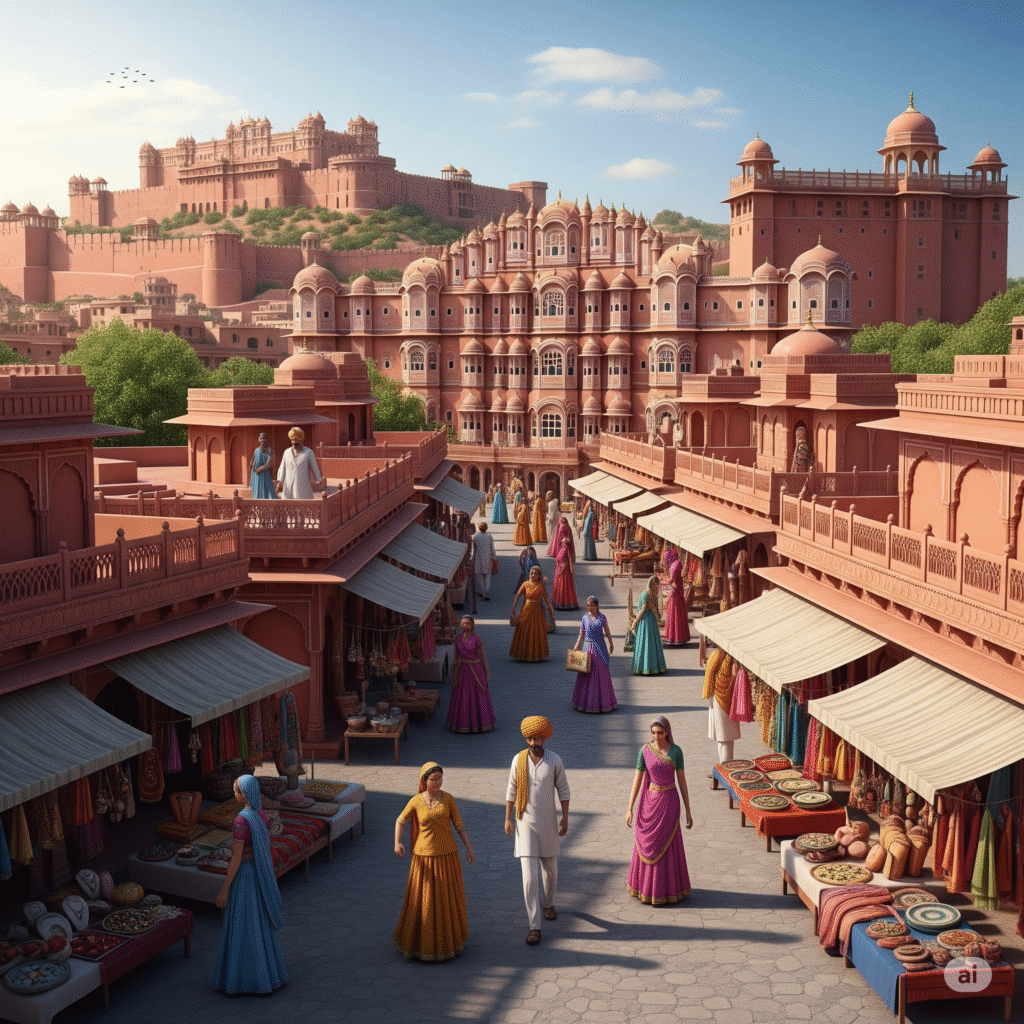
Detailed description of major tourist places of Jaipur
Jaipur , known as the “Pink City” , is not only the capital of Rajasthan but also one of the most important tourist destinations in India. Jaipur is famous for its forts , palaces , museums , and traditional markets. The city offers a unique blend of architecture , art , and culture.
1. Amber Fort
- Location : Situated in the Aravalli Hills, 11 km from Jaipur .
- Speciality :
- Amer Fort , the most famous fort in Jaipur , was built by Maharaja Mansingh I.
- The fort has a beautiful blend of Rajput and Mughal architecture.
- The Sheesh Mahal , the Diwan-i-Aam , and Diwan-i-Khas These are the main attractions here.
- Elephant Safari And light end sound show Very popular among tourists.
2. Hawa Mahal
- Location : Located in the heart of Jaipur.
- Speciality :
- It is called the “Palace of the Winds”.
- This palace was built by Maharaja Sawai Pratap Singh in 1799 .
- Having 953 jharokhas (windows), it is a unique example of Rajput architecture.
- It was created for women so that they could observe outdoor activities.
- Built of red and pink sandstone, this palace is a symbol of the Pink City.
3. City Palace
- Location : Located in the heart of Jaipur.
- Speciality :
- The City Palace was built by Maharaja Sawai Jai Singh II in 1732 .
- This palace is a mixture of Rajput , Mughal and European architecture.
- Here Chandra Mahal And Mubarak Palace are the major parts.
- The museum houses a collection of royal clothing , weapons , and ancient paintings.
- Chandra Mahal is still the residence of the royal family.
4. Jantar Mantar
- Location : Near City Palace.
- Speciality :
- This astronomical observatory was built by Sawai Jai Singh II in 1734 .
- It is a UNESCO World Heritage Site.
- It houses 19 astronomical instruments , used to measure time , study the motion of planets, and predict celestial phenomena.
- Samrat Yantra This is the biggest tool here.
5. Jaigarh Fort
- Location : Near Amer Fort.
- Speciality :
- It was built by Sawai Jai Singh II in 1726 .
- This fort is called “Fort of Victory”.
- Here Jayvon Cannon It is situated here , which is considered to be the world’s largest cannon placed on wheels.
- The fort also has an armoury , water tanks , and tunnels.
- This fort is connected to the Amer Fort through a secret passage.
6. Nahargarh Fort
- Location : Aravalli Hills.
- Speciality :
- This fort was built in 1734 by Sawai Jai Singh II.
- It was built for the security of Jaipur.
- A spectacular view of Jaipur city can be seen from the fort.
- here movies like rang de basanti has been shot.
- This fort is a special attraction for tourists at sunset.
7. Water Palace
- Location : In the middle of Man Sagar Lake.
- Speciality :
- This palace was built by Sawai Madho Singh in the 18th century .
- This is a five-storey palace , in which four floors remain submerged under water.
- It is an excellent example of Mughal and Rajput architecture.
- Bird watching can be enjoyed around the lake.
- Boating facility is available for tourists.
8. Albert Hall Museum
- Location : Located in Ram Niwas Garden.
- Speciality :
- This is the oldest museum in Rajasthan , which was built in 1887 .
- It houses a collection of ancient artefacts , weapons , clothing , jewellery , and paintings.
- Egyptian mummy is the main attraction here.
9. Birla Temple
- Location : Below Moti Dungri Hill.
- Speciality :
- This temple is dedicated to Lord Vishnu (Lakshmi Narayan).
- Made of white marble, this temple shines in the light at night.
- This temple is famous for its architecture and peaceful atmosphere.
10. Galta Ji Temple
- Location : In the Aravalli Hills.
- Speciality :
- This temple is famous as “Monkey Temple” due to the large number of monkeys.
- There are natural water ponds here , which are considered sacred.
- The temple is dedicated to Lord Rama and Krishna.
11. Chokhi Dhani
- Location : On the outskirts of Jaipur.
- Speciality :
- It is a theme based resort , which reflects the traditional Rajasthani lifestyle.
- , music , puppet shows , camel rides , and traditional Rajasthani food can be experienced here .
- It is very popular among tourists.
12. Rambagh Palace
- Location : In the center of Jaipur.
- Speciality :
- It is the royal palace of Jaipur , which has now been converted into a luxury hotel.
- This palace offers the experience of Rajput royal lifestyle.
13. Jawahar Circle
- Location : Near Jaipur Airport.
- Speciality :
- It is the largest circular park in Asia.
- from here septum gate It is the main attraction for tourists.
Experience of traveling to Jaipur
The tourist places of Jaipur not only reflect the historical heritage but also provide a unique experience of its culture , tradition , and architecture.
- Every place in Jaipur tells its own story.
- Shopping in the markets here , Rajasthani cuisine , and local folk art make your trip memorable.
conclusion
Jaipur , due to its rich history and diverse cultural heritage , is one of the major tourist destinations in India. The forts , palaces , museums , and markets of the Pink City offer a unique experience to the tourists. This city is a wonderful amalgamation of the past and modernity , which provides a memorable experience to every traveler.
Food & Drink in Jaipur
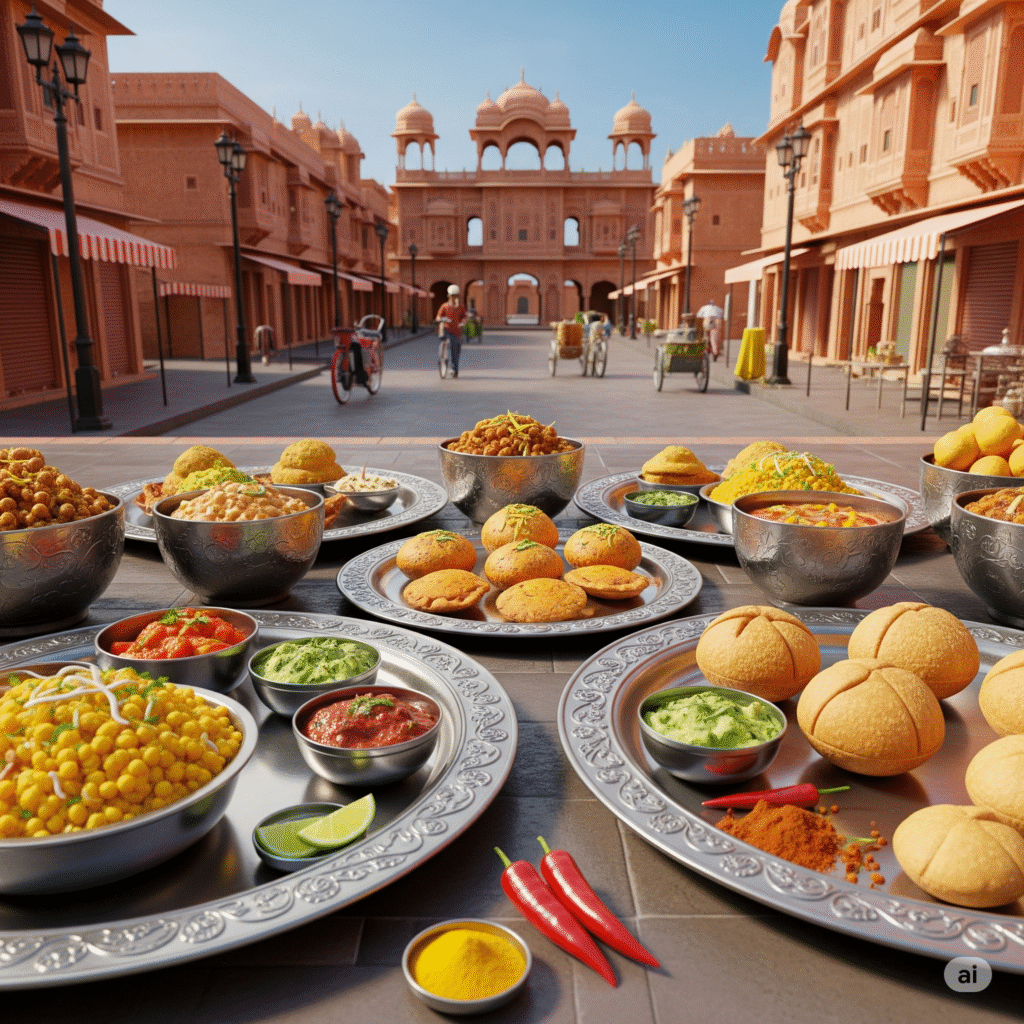
Food in Jaipur: A journey of traditional tastes and delicacies
Jaipur’s cuisine is a symbol of its rich culture and traditions. The cuisine here presents a wonderful blend of the diversity of Rajasthani food , the unique aroma of spices , and traditional taste. Jaipur mainly has the influence of royal Rajput cuisine and rural food traditions.
1. Rajasthani Thali: The Complete Dining Experience
Rajasthani thali is the centerpiece of Jaipur’s cuisine. It consists of various dishes served together:
- : Dal Baati Churma :
- Baati (round wheat bread) is served dipped in ghee.
- Accompany it with spicy tuvar or moong dal.
- Meetha Churma (made of Baati mixed with sugar and ghee).
- Gatta ki sabzi :
- Gatta (round pieces) made from gram flour are cooked in a spicy gravy.
- Curry :
- A mildly sour curry made from yogurt and gram flour.
- Bajra roti and garlic chutney :
- Bajra roti is served with ghee.
2. Sweets of Jaipur
Jaipur’s sweets are an important part of its traditional cuisine:
- Ghevar :
- is a honey shaped crispy sweet which is specially made on Teej and Rakshabandhan.
- is garnished with cream , saffron , and dry fruits.
- Feeni :
- A sweet made from fine vermicelli , which is eaten with cold rabri.
- Malpua :
- Sweet Puri served with Kheer or Rabri.
- Mawa Kachori :
- Kachori filled with khoya (mawa) and nuts.
- Churma Laddu :
- Laddus made from wheat flour , jaggery , and ghee.
3. Breakfast and Snacks
The local snacks and breakfast of Jaipur are not only delicious but also famous all over India:
- Onion Kachori :
- Deep fried kachori filled with onions , spices and gram flour.
- Chilli big :
- Big green chillies are stuffed with spices, wrapped in gram flour and fried.
- Dahi Bade :
- Soft urad dal vadas dipped in curd.
- Crispy Kachori :
- Crispy kachori filled with moong dal or potatoes.
4. Beverages
Cold and hot drinks are equally famous in Jaipur:
- Saffron Lassi :
- Sweet lassi made from thick yogurt , served with saffron and nuts.
- Matka Kulfi :
- Kulfi frozen in a pot in the traditional style.
- Tea and Masala Milk :
- A blend of ginger and spices in local tea Gives amazing taste.
5. Special Rajasthani Dishes
Jaipur’s cuisine is distinguished by its spices and traditional cooking methods:
- Ker Sangri :
- Ker (a type of wild fruit) and Sangri (dry beans) are cooked in spices and ghee.
- It is an integral part of Rajasthani cuisine.
- red meat :
- Spicy mutton curry , cooked in Rajasthani red chillies and ghee.
- It is a symbol of Rajput cuisine.
- Mohan Meat :
- Slow cooked Mutton in a creamy gravy.
- Pitore ki sabzi :
- Besan pieces are cooked in a spicy gravy.
- Fusion of Churma Dal Baati :
- This is a typical example of Jaipur food , where traditional dishes are served in a new style.
6. Traditional Rotis and Rice
Rotis and rice have a different significance in the traditional Jaipur meal:
- Bajra roti :
- It is specially made in winters and is eaten with jaggery and ghee.
- Corn bread :
- The famous bread eaten with mustard greens.
- Masala Baati :
- Baati stuffed with spices and cooked in a tandoor.
7. Modern and Street Food
Along with traditional food, modern food trends are also popular in Jaipur:
- Pav Bhaji and Chole Bhature :
- Part of Jaipur street food.
- Golgappas and Dahi Puri :
- Delicious snacks available in the markets here.
- Pizza and Burgers :
- Enjoy fusion food with traditional taste.
8. Markets and Food Places
Major markets and eating places in Jaipur:
- Laxmi Mishthan Bhandaar ( LMB) :
- Famous for Daal Baati Churma and sweets.
- Chowki Dhani :
- A complete experience of traditional Rajasthani food.
- Fat King :
- Famous for enjoying Rajasthani thali.
- Bapu Bazaar and Johri Bazaar :
- The street food experience here is memorable for the tourists.
conclusion
Jaipur food is not just food , it is a taste of Rajasthan’s tradition , culture, and history. Spice-rich dishes , sweet delicacies , and food served in traditional Rajasthani style are the hallmarks of Jaipur. Whether you want to taste traditional food or modern fusion dishes , Jaipur has something special for everyone.
Festivals and Fairs
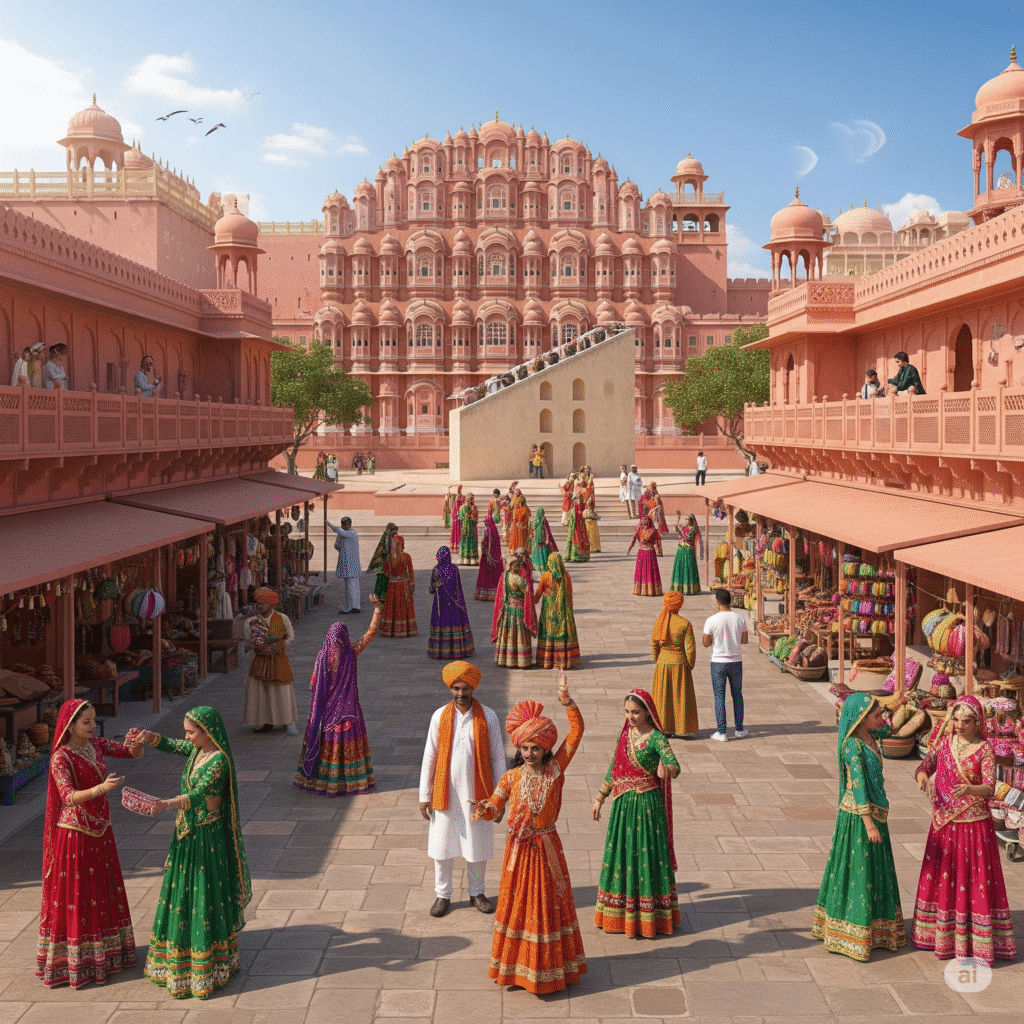
Festivals and Fairs of Jaipur: A Celebration of Culture and Traditions
Jaipur , known as the “Pink City” , is not only famous for its architecture and history , but its festivals and fairs are also its identity. These festivals are a wonderful example of the rich cultural heritage and traditional customs of this city. Not only local people but also tourists from India and abroad participate in the festivals and fairs of Jaipur.
1. Teej Festival
- Time : Saavan (July-August)
- Importance :
- This festival is dedicated to the reunion of Lord Shiva and Goddess Parvati.
- Married women observe fast for the long life and happiness of their husbands.
- Special attractions :
- A tableau of Teej Mata is taken out , which includes traditional clothing , jewelry , and bands.
- Women swing , apply henna , and sing traditional songs.
- Ghevar sweet is a major part of this festival.
2. Gangaur Festival
- Time : Chaitra (March-April)
- Importance :
- This festival is dedicated to Goddess Gauri (Parvati).
- Married women pray for the happiness and prosperity of their husbands and unmarried girls pray for a good groom.
- Special attractions :
- The idols of Goddess Gauri and Lord Shiva are decorated and a tableau is taken out.
- Women in traditional attire perform puja and sing folk songs.
- This festival is organised in a grand manner at Johari Bazaar and Tripolia Gate.
3. Kite Festival
- Time : Makar Sankranti ( January 14 )
- Importance :
- This festival is celebrated to worship the Sun God and mark the beginning of the New Year.
- Special attractions :
- The whole sky gets filled with colourful kites.
- Kite flying competitions are organised.
- sesame and jaggery laddus , gajak , and pheni are specially eaten on this day.
4. Jaipur Literature Festival
- Time : January
- Importance :
- This is the world’s largest literary festival.
- Special attractions :
- literature , art , and culture.
- Congregation of national and international writers and poets.
- Cultural presentations and concerts.
5. Holi
- Time : Phalgun Purnima (March)
- Importance :
- This festival of colours symbolizes the victory of good over evil.
- Special attractions :
- Holi festival is celebrated in traditional manner in Jaipur.
- Elephant Festival is organised , in which elephants are decorated and paraded.
- Holi is played with colours and flowers.
6. Diwali
- Time : Kartik month (October-November)
- Importance :
- This festival is celebrated to mark the return of Lord Rama to Ayodhya.
- Special attractions :
- The entire Jaipur city is decorated with lights and lamps.
- There is an atmosphere of decoration and shopping in the markets.
- Places like Albert Hall and Hawa Mahal are specially decorated.
7. Sheetla Ashtami
- Time : One week after Holi
- Importance :
- This festival is celebrated to worship Goddess Sheetala.
- There is a tradition of consuming cold food on this day.
- Special attractions :
- Worship in Shitala Mata temples.
- This festival has religious and traditional significance.
8. Jaipur International Film Festival ( JIFF)
- Time : January
- Importance :
- The festival connects Jaipur with the international film community.
- Special attractions :
- Screening of national and international films.
- Opportunity to meet filmmakers and artists.
9. Desert Festival
- Location : Adjacent Thar Desert area.
- Special attractions :
- Traditional folk dance and music.
- Camel races , turban tying competition , and local crafts.
10. Champa Shashti and other regional festivals
- Speciality :
- Festivals of local deities are celebrated in the rural areas of Jaipur.
- Traditional games , dances and fairs are organized in it .
Major fairs of Jaipur
1. Pushkar Fair
- Location : Pushkar, 150 km from Jaipur .
- Speciality :
- This is the world’s largest camel fair.
- Traditional music , dance , and camel decoration competition.
- Bathing in Pushkar Lake and worshipping at the Brahma Temple.
2. Chandpole Fair
- Location : Jaipur City.
- Speciality :
- Shopping for local handicrafts and traditional clothing.
- Folk arts and cultural programs.
3. Arts Festival
- Speciality :
- Showcase of local artists and handicrafts of Jaipur.
conclusion
Jaipur’s festivals and fairs keep its cultural richness and traditions alive. These festivals not only hold religious or cultural significance but also make Jaipur a hub of art , music , and community celebrations. Jaipur’s fairs and festivals make it a vibrant city where every day feels like a celebration.
Modernity and development in Jaipur
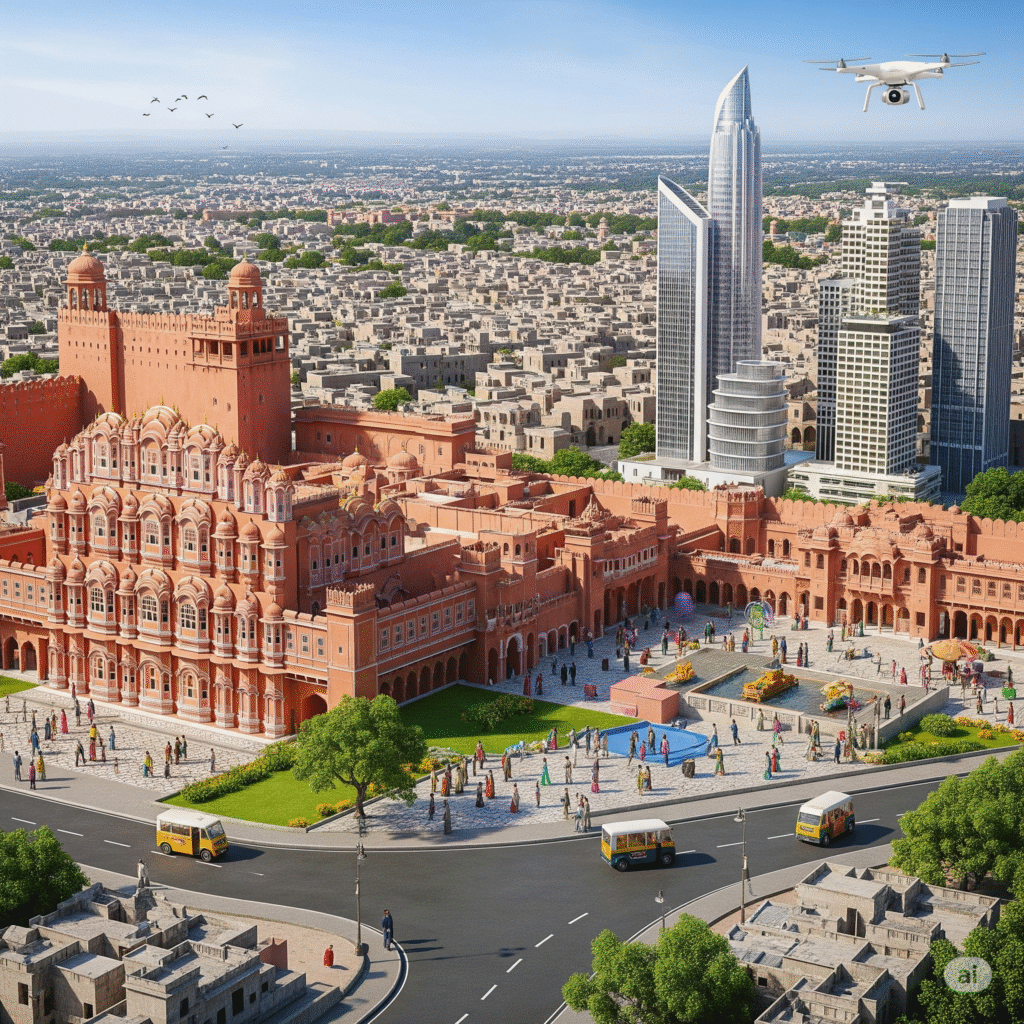
Modernity and development in Jaipur: A blend of innovation with tradition
Jaipur , known as the “Pink City” , is not only famous for its historical heritage and traditions , but is also moving towards modernity and development. A unique blend of antiquity and modernity can be seen here. This city has made rapid progress in the technological , educational , and economic fields while maintaining its historical importance.
1. Infrastructure and urban development
Jaipur has preserved its historical structures While preserving it, modern buildings and infrastructure have been developed.
- Metro Rail Project :
- Jaipur Metro is the first metro rail service in Rajasthan , which helps in smoothening the traffic of the city.
- Smart City Project :
- Jaipur is being developed as a smart city.
- focuses on IT services , sanitation , and traffic management.
- Jaipur International Airport :
- This airport is equipped with state-of-the-art facilities and is considered the main air traffic hub of Rajasthan.
- Residential and Commercial Projects :
- Modern residential and commercial buildings have developed in areas like Tonk Road , Jagatpura , and Mansarovar.
2. Industry and trade
Jaipur has also made significant progress in the field of trade and industry.
- Handicrafts and Gems-Jewellery Industry :
- Jaipur is world famous for its handicrafts and jewellery.
- Gems and jewellery are exported here on a large scale.
- IT & Startup Hub :
- Jaipur is the emerging IT hub of Rajasthan.
- Many IT companies have been established in areas like Mansarovar and Sitapura.
- Initiatives like “Startup Oasis” have been taken to promote startups.
- Industrial Area :
- , construction , and food processing units have expanded in the Sitapura and Vishwakarma industrial areas .
3. Education and research
Jaipur is also a leader in the field of education and can be seen as an “educational hub”.
- Major Universities and Institutes :
- Institutions like Rajasthan University , Malaviya National Institute of Technology ( MNIT), and Amity University have made it an educational hub.
- Medical and Research Centre :
- Medical education and research is being promoted in Sawai Mansingh Medical College and other institutions.
- Digital Education :
- Jaipur has promoted technical education through online education and e-learning.
4. Development of tourism industry
Jaipur’s tourism industry makes it one of the top tourist destinations in the world.
- Modern facilities for tourism :
- Luxurious hotels and resorts have been built , such as the Leela Palace , the Taj Rambagh , and the Oberoi Rajvilas.
- The use of electric vehicles and guiding apps has increased.
- Modern Tourism Schemes :
- Night tourism is being promoted.
- Cultural villages like Chowki Dhani attract tourists.
5. Transport and traffic
Jaipur has used modern technologies in its transportation and traffic management.
- Jaipur Metro :
- This is a successful step to solve the traffic problem.
- National Highway and Ring Road :
- Traffic has become smooth on Delhi-Jaipur and Ajmer-Jaipur highways.
- Smart Parking and E-Vehicles :
- Electric vehicles and smart parking systems have been implemented.
6. Medical and health services
Jaipur has also made remarkable progress in health services.
- Super Specialty Hospitals :
- Medical facilities like Sawai Mansingh Hospital and Mahatma Gandhi Hospital are available.
- Telemedicine :
- Telemedicine services have expanded in rural areas.
- Ayurveda and Yoga :
- Centers have been opened to promote traditional medical practices.
7. Arts , Music , and Entertainment
Modern art and culture have also been promoted in Jaipur.
- Jaipur Literature Festival ( JLF) :
- This is the world’s largest literary festival.
- Modern art galleries :
- Organising art exhibitions at Jawahar Kala Kendra and other places.
- Cinema and Entertainment :
- Multiplexes and entertainment zones have promoted modern entertainment.
8. Environmental protection and cleanliness
Jaipur has also taken new steps in environmental protection and cleanliness.
- Green Jaipur Campaign :
- Tree plantation and construction of parks have been promoted.
- Solar Energy :
- Jaipur is a leader in the use of solar power.
- Clean India Mission :
- Various schemes have been implemented to make Jaipur clean and pollution free.
9. E-commerce and Digital India
Digital services and e-commerce have expanded extensively in Jaipur.
- Digital Payments :
- Digital payments and cashless transactions have been promoted.
- E-Governance :
- Citizen services have been made available online.
conclusion
Jaipur has made remarkable progress in every field by establishing a balance between traditions and modernity. On one hand, its identity is associated with historical sites and cultural heritage , while on the other hand, modern technological development , urbanization , and environmental protection make it an ideal city. Jaipur is one such city of India , which cherishes the glimpse of its past and the dreams of the future together.